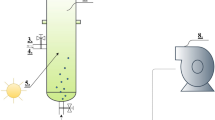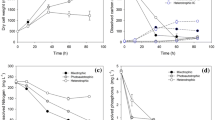Abstract
In this study, the microalga Scenedesmus dimorphus was cultivated phototrophically using unsterilized anaerobic digestate as a nutrient medium. A bench-scale experiment was conducted by inoculating the microalga S. dimorphus with 0.05–10% dilutions of the anaerobic digestate supernatant. It was found that 1.25–2.5% dilutions, which is equivalent to 50–100 mg N/L total nitrogen concentrations and 6–12 mg P/L total phosphorus concentrations, provided sufficient nutrients to maximize the growth rate along with achieving high concentrations of algal biomass. The microalgae cultivation was scaled up to 100 L open raceway ponds, where the effect of paddlewheel mixing on the growth was investigated. It was concluded that 0.3 m/s water surface velocity yielded the highest specific growth rate and biomass concentration compared to 0.1 and 0.2 m/s. The microalga S. dimorphus was then cultivated in the raceway ponds using 2.5% diluted anaerobic digestate at 317 and 454 μmol/(m2 × s) average incident light intensities and 1.25% diluted anaerobic digestate at 234 and 384 μmol/(m2 × s) average incident light intensities. The maximum biomass concentration was 446 mg/L which was achieved in the 2.5% dilution and 454 μmol/(m2 × s) light intensity culture. Moreover, nitrogen, phosphorus, and COD removal efficiencies from the nutrient media were 65–72, 63–100, and 78–82%, respectively, whereas ammonia was completely removed from all cultures. For a successful and effective cultivation in open raceway ponds, light intensity has to be increased considerably to overcome the attenuation caused by the algal biomass as well as the suspended solids from the digestate supernatant.






Similar content being viewed by others
References
Terry KT, Raymond LP (1985) System design for the autotrophic production of microalgae. Enzyme Microb Technol 7:474–487
Chen Y, Wang J, Zhang W, Chen L, Gao L, Liu T (2013) Forced light/dark circulation operation of open pond for microalgae cultivation. Biomass Bioenergy 56:464–470
Mata TM, Martins AA, Caetano NS (2010) Microalgae for biodiesel production and other applications: a review. Renew Sustain Energy Rev 14:217–232
James SC, Boriah V (2010) Modeling algae growth in an open-channel raceway. J Comput Biol 17:895–906
Lunka AA, Bayless DJ (2013) Effects of flashing light-emitting diodes on algal biomass productivity. J Appl Phycol 25(6):1679–1685
Choi HJ, Lee SM (2012) Effects of microalgae on the removal of nutrients from wastewater: various concentrations of Chlorella vulgaris. Environ Eng Res 17(S1):S3–S8
Tam NFY, Wong YS (1990) The comparison of growth and nutrient removal efficiency of Chlorella pyrenoidosa in settled and activated sewages. Environ Pollut 65(2):93–108
Abu Hajar HA, Riefler RG, Stuart BJ (2016) Anaerobic digestate as a nutrient medium for the growth of the green microalga Neochloris oleoabundas. Environ Eng Res 21(3):265–275
Park J, Jin HF, Lim BR, Park KY, Lee K (2010) Ammonia removal from anaerobic digestion effluent of livestock waste using green alga Scenedesmus sp. Bioresour Technol 101(22):8649–8657
Tam NFY, Wong YS (1996) Effect of ammonia concentrations on growth of Chlorella vulgaris and nitrogen removal from media. Bioresour Technol 57(1):45–50
Travieso L, Benítez F, Sánchez E, Borja R, Martín A, Colmenarejo MF (2006) Batch mixed culture of Chlorella vulgaris using settled and diluted piggery waste. Ecol Eng 28(2):158–165
Renaud SM, Parry DL, Thinh LV (1994) Microalgae for use in tropical aquaculture I: gross chemical and fatty acid composition of twelve species of microalgae from the Northern Territory, Australia. J Appl Phycol 6(3):337–345
Oron G, Shelef G, Levi A (1981) Environmental phenotypic variation of Scenedesmus dimorphus in high-rate algae ponds and its relationship to wastewater treatment and biomass production. Biotechnol Bioeng 23(10):2185–2198
Frigon JC, Matteau-Lebrun F, Abdou RH, McGinn PJ, O’Leary SJ, Guiot SR (2013) Screening microalgae strains for their productivity in methane following anaerobic digestion. Appl Energy 108:100–107
Vidyashankar S, Deviprasad K, Chauhan VS, Ravishankar GA, Sarada R (2013) Selection and evaluation of CO2 tolerant indigenous microalga Scenedesmus dimorphus for unsaturated fatty acid rich lipid production under different culture conditions. Bioresour Technol 144:28–37
Jiang Y, Zhang W, Wang J, Chen Y, Shen S, Liu T (2013) Utilization of simulated flue gas for cultivation of Scenedesmus dimorphus. Bioresour Technol 128:359–364
Giannetto MJ, Retotar A, Rismani-Yazdi H, Peccia J (2015) Using carbon dioxide to maintain an elevated oleaginous microalga concentration in mixed-culture photo-bioreactors. Bioresour Technol 185:178–184
González LE, Cañizares RO, Baena S (1997) Efficiency of ammonia and phosphorus removal from a Colombian agroindustrial wastewater by the microalgae Chlorella vulgaris and Scenedesmus dimorphus. Bioresour Technol 60(3):259–262
Kang J, Wen Z (2015) Use of microalgae for mitigating ammonia and CO2 emissions from animal production operations—evaluation of gas removal efficiency and algal biomass composition. Algal Res 11:204–210
Ruangsomboon S, Ganmanee M, Choochote S (2013) Effects of different nitrogen, phosphorus, and iron concentrations and salinity on lipid production in newly isolated strain of the tropical green microalga, Scenedesmus dimorphus KMITL. J Appl Phycol 25(3):867–874
Wang L, Li Y, Sommerfeld M, Hu Q (2013) A flexible culture process for production of the green microalga Scenedesmus dimorphus rich in protein, carbohydrate or lipid. Bioresour Technol 129:289–295
Goswami RCD, Kalita MC (2011) Scenedesmus dimorphus and Scenedesmus quadricauda: two potent indigenous microalgae strains for biomass production and CO2 mitigation—a study on their growth behavior and lipid productivity under different concentration of urea as nitrogen source. J Algal Biomass Utln 2(4):42–49
Welter C, Schwenk J, Kanani B, Van Blargan J, Belovich JM (2013) Minimal medium for optimal growth and lipid production of the microalgae Scenedesmus dimorphus. Environ Prog Sustain Energy 32(4):937–945
Wang B, Lan CQ (2011) Biomass production and nitrogen and phosphorus removal by the green alga Neochloris oleoabundans in simulated wastewater and secondary municipal wastewater effluent. Bioresour Technol 102(10):5639–5644
Pittman JK, Dean AP, Osundeko O (2011) The potential of sustainable algal biofuel production using wastewater resources. Bioresour Technol 102(1):17–25
de Winter L, Klok AJ, Franco MC, Barbosa MJ, Wijffels RH (2013) The synchronized cell cycle of Neochloris oleoabundans and its influence on biomass composition under constant light conditions. Algal Res 2(4):313–320
Clesceri L, Greenberg A, Eaton A (1998) Standard methods for the examination of water and wastewater, 20th edn. American Public Health Association, Washington DC
James DE (1978) Culturing algae. Carolina Biological Supply Company, Burlington, NC
Xu X, Shen Y, Chen J (2015) Cultivation of Scenedesmus dimorphus for C/N/P removal and lipid production. Electron J Biotechnol 18(1):46–50
Green FB, Lundquist TJ, Oswald WJ (1995) Energetics of advanced integrated wastewater pond systems. Water Sci Technol 31:9–20
Hadiyanto H, Elmore S, Van Gerven T, Stankiewicz A (2013) Hydrodynamic evaluations in high rate algae pond (HRAP) design. Chem Eng J 217:231–239
Kunikane S, Kaneko M, Maehara R (1984) Growth and nutrient uptake of green alga, Scenedesmus dimorphus, under a wide range of nitrogen/phosphorus ratio—I. Experimental study. Water Res 18(10):1299–1311
Kunikane S, Kaneko M (1984) Growth and nutrient uptake of green alga, Scenedesmus dimorphus, under a wide range of nitrogen/phosphorus ratio—II. Kinetic model. Water Res 18(10):1313–1326
Rhee GY (1978) Effects of N:P atomic ratios and nitrate limitation on algal growth, cell composition, and nitrate uptake. Limnol Oceanogr 23(1):10–25
Arumugam M, Agarwal A, Arya MC, Ahmed Z (2013) Influence of nitrogen sources on biomass productivity of microalgae Scenedesmus bijugatus. Bioresour Technol 131:246–249
Klausmeier CA, Litchman E, Daufresne T, Levin SA (2004) Optimal nitrogen-to-phosphorus stoichiometry of phytoplankton. Nature 429(6988):171–174
Benider A, Tahiri M, Belkoura M, Dauta A (2001) Interaction des facteurs héliothermiques sur la croissance de trois espèces du genre Scenedesmus. Ann Limnol 37(4):257–266
Acknowledgements
This work was funded entirely by the National Science Foundation (NSF) through the Sustainable Energy Pathways (SEP) program (Award # 1230961).
Author information
Authors and Affiliations
Corresponding author
Ethics declarations
Conflict of interest
The authors of this manuscript declare that they have no competing interests.
Rights and permissions
About this article
Cite this article
Abu Hajar, H.A., Riefler, R.G. & Stuart, B.J. Cultivation of Scenedesmus dimorphus using anaerobic digestate as a nutrient medium. Bioprocess Biosyst Eng 40, 1197–1207 (2017). https://doi.org/10.1007/s00449-017-1780-4
Received:
Accepted:
Published:
Issue Date:
DOI: https://doi.org/10.1007/s00449-017-1780-4




